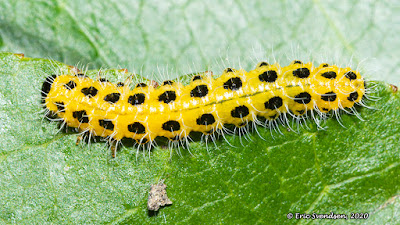Yellow spotted caterpillar sawfly larva.
Upon first glance, you might think this was a caterpillar of a butterfly or moth. It is, however, the larva of a sawfly. I had quite a banner year photographing insects and was thrilled to find that many of my acquisitions were either sawflies or sawfly larvae. Many sawfly caterpillars look like the larva of their insect cousins, the Lepidoptera. However, there is an easy way to tell them apart.
All insects have six legs. Like the adults, caterpillars also have six legs, but they have an additional set of false legs called prolegs. They are at the rear of the larva and help it to adhere to and move along whatever substrate they happen to be on. Lepidoptera prolegs are usually limited to five or six pairs and are found only near the larva's posterior. Sawfly larvae have more prolegs and go right up the caterpillar to just behind the six true legs. If you find a caterpillar with only a few pairs of prolegs it is a butterfly or moth. If it has prolegs going all the way from the rear of the organism right up to its true legs, it is a sawfly. (There is a good image at this website).
That brings us to the question, "What in the world is a sawfly?" Unlike insects such as horseflies, robber flies, houseflies, and blowflies, sawflies do not belong to the fly family (Diptera). Instead, they belong to the Hymenoptera, which includes bees, ants, wasps, and horntails (I found one of these this summer too). Unlike bees, wasps, and some ant species, sawfly adults cannot sting. The adults feed on a variety of substances, depending on the species. Some are hunters, others take pollen, nectar, or sap, or will feed on the body fluids of captured prey. The name sawfly comes from the shape of the female ovipositor, which is saw shaped. They use it to cut into plant stems where eggs are laid. This is where adults do some damage, but it is the larvae that are the most destructive.
Sawfly larvae tend to be innocuous when it comes to damaging valuable plants. The larvae feed only on a very narrow range of vegetation which is very much species-specific. For example, one species feeds only on honeysuckle. There are sawflies which can be enormous pests though. Wheat-stem sawfly larvae feed on wheat and can remove the grain laden heads in the process of feeding. The yellow-spotted caterpillar sawfly I photographed apparently feeds on red-osier dogwood leaves.
Thanks for reading. Ericspix Eric Svendsen
All insects have six legs. Like the adults, caterpillars also have six legs, but they have an additional set of false legs called prolegs. They are at the rear of the larva and help it to adhere to and move along whatever substrate they happen to be on. Lepidoptera prolegs are usually limited to five or six pairs and are found only near the larva's posterior. Sawfly larvae have more prolegs and go right up the caterpillar to just behind the six true legs. If you find a caterpillar with only a few pairs of prolegs it is a butterfly or moth. If it has prolegs going all the way from the rear of the organism right up to its true legs, it is a sawfly. (There is a good image at this website).
That brings us to the question, "What in the world is a sawfly?" Unlike insects such as horseflies, robber flies, houseflies, and blowflies, sawflies do not belong to the fly family (Diptera). Instead, they belong to the Hymenoptera, which includes bees, ants, wasps, and horntails (I found one of these this summer too). Unlike bees, wasps, and some ant species, sawfly adults cannot sting. The adults feed on a variety of substances, depending on the species. Some are hunters, others take pollen, nectar, or sap, or will feed on the body fluids of captured prey. The name sawfly comes from the shape of the female ovipositor, which is saw shaped. They use it to cut into plant stems where eggs are laid. This is where adults do some damage, but it is the larvae that are the most destructive.
Sawfly larvae tend to be innocuous when it comes to damaging valuable plants. The larvae feed only on a very narrow range of vegetation which is very much species-specific. For example, one species feeds only on honeysuckle. There are sawflies which can be enormous pests though. Wheat-stem sawfly larvae feed on wheat and can remove the grain laden heads in the process of feeding. The yellow-spotted caterpillar sawfly I photographed apparently feeds on red-osier dogwood leaves.
Thanks for reading. Ericspix Eric Svendsen




Comments
Post a Comment